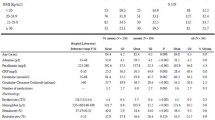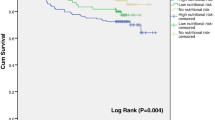Abstract
Background
Anemia and hypoalbuminemia (HA) are acknowledged independent risk factors for morbidity and mortality in geriatric patients and are associated with nutritional status and frailty. Data exist regarding the association between albumin and frailty, anemia and frailty as well as frailty and nutritional status; however, there is a lack of information on the association between HA, anemia and nutritional status in older people.
Patients and methods
This study retrospectively analyzed 626 patients admitted to a German geriatrics department (average age 81.1 years, 68.2 % female and 31.8 % male) for anemia and HA. Data from the comprehensive geriatric assessment (CGA) and from the mini-nutritional assessment (MNA) were available in all patients.
Results
Patients with anemia suffered significantly more often from HA (p < 0.001) than patients without anemia, with an odds ratio (OR) of 1.99 (95 % confidence interval CI: 1.2-3.2) and of 5.41 (CI 95 %: 2.3-12.6) in patients at risk for malnutrition and in malnourished patients, respectively. A moderately significant association was seen between hemoglobin (Hb) and albumin values (Pearson’s correlation r = 0.330; p < 0.001) as well as between albumin values and the Barthel index (Spearman’s correlation r = 0.210; p < 0.001).
Conclusion
Anemia appears to be a risk factor for HA in inpatients with malnutrition and the observed association between albumin and Hb warrants further research. Geriatric inpatients with anemia should be evaluated in terms of the presence of malnutrition risk and HA.
Zusammenfassung
Hintergrund
Anämie und Hypoalbuminämie (HA) sind bei geriatrischen Patienten bekannte unabhängige Risikofaktoren für Morbidität und Mortalität, sie stehen im Zusammenhang mit Ernährungststatus und Frailty. Es gibt Untersuchungen zum Zusammenhang zwischen Albumin und Frailty, Anämie und Frailty, sowie Frailty und dem Ernährungsstatus. Bisher fehlen jedoch Daten zu einem Zusammenhang zwischen HA, Anämie und Ernährungsstatus bei geriatrischen Patienten.
Patienten und Methoden
Retrospektive Datenanalyse von 626 stationären geriatrischen Patienten (mittleres Alter 81,1 Jahre, 68,2 % Frauen, 31,8 % Männer) hinsichtlich Anämie, HA und einem Zusammenhang mit dem Ernährungsstatus (Mini Nutritional Assessment, MNA) und dem multidimensionalen geriatrischen Assessment (Comprehensive Geriatric Assessment, CGA).
Ergebnisse
Patienten mit Anämie wiesen signifikant häufiger eine HA auf (p < 0,001) als Patienten ohne Anämie, wobei anämische Patienten mit einem Risiko für Mangelernährung eine erhöhte Chance auf eine HA hatten (OR I,9; 95 %-KI: 1,2-3,2) und Patienten mit einer Mangelernährung eine OR von 5,4 (95 %-KI: 2,3-12,6) aufwiesen. Ein moderater signifikanter Zusammenhang konnte gezeigt werden zwischen Hämoglobin (Hb) und Albumin (Pearsons Korrelationskoeffizient r = 0,330; p < 0,001) sowie zwischen Albumin und Barthel Index.
Schlussfolgerungen
Anämie scheint bei mangelernährten stationär geriatrischen Patienten ein Risikofaktor für HA zu sein, wobei der beobachtete Zusammenhang zwischen Albumin und Hb weiterer wissenschaftlicher Untersuchungen bedarf. Im klinischen Alltag sollte bei stationär geriatrischen Patienten mit Anämie eine Überprüfung auf HA erwogen werden, besonders bei drohender oder bereits bestehender Mangelernährung.
Similar content being viewed by others
References
Andro M, Le Squere P, Estivin S, Gentric A (2013) Anaemia and cognitive performances in the older people: a systematic review. Eur J Neurol 20(9):1234–1240
Barchel D, Almoznino-Sarafian D, Shteinshnaider M, Tzur I, Cohen N, Gorelik O (2013) Clinical characteristics and prognostic significance of serum albumin changes in an internal medicine ward. Eur J Intern Med 24(8):772–778
Beghé C, Wilson A, Ershler WB (2004) Prevalence and outcomes of anaemia in geriatrics: a systematic review of the literature. Am J Med 116(Suppl 7A):3S–10S
Blanc B, Finch CA, Hallberg L (1968) Nutritional anaemias. Report of a WHO Scientific Group. World Health Organ Tech Rep Ser 405:1–40
Bollwein J, Volkert D, Diekmann R, Kaiser MJ, Uter W, Vidal K, Sieber CC, Bauer JM (2013) Nutritional status according to the mini nutritional assessment (MNA®) and frailty in community dwelling older persons: a close relationship. J Nutr Health Aging 17(4):351–356
Bonilla-Palomas JL, Gámez-López AL, Moreno-Conde M, López-Ibáñez MC, Anguita-Sánchez M, Gallego de la Sacristana A, García-Catalán F, Villar-Ráez A (2014) Hypoalbuminemia in acute heart failure patients: causes and its impact on hospital and long-term mortality. J Card Fail 20(5):350–358
Cankurtaran M, Yavuz BB, Halil M, Ulger Z, Haznedaroglu IC, Ariogul S (2012) Increased ferritin levels could reflect ongoing aging-associated inflammation and may obscure underlying iron deficiency in the geriatric population. Eur Geriatr Med 3:277–280
Chan TC, Yap DY, Shea YF, Luk JK, Chan FH, Chu LW (2013) Prevalence of anaemia in Chinese nursing home older adults: implication of age and renal impairment. Geriatr Gerontol Int 13(3):591–596
Chi Z, Mi SH, Zhang XX, Guan Y, Zhao QM, Wu XS (2012) Impact of anaemia on long-term outcome in older people patients with acute coronary syndrome undergoing percutaneous coronary interventions. Zhonghua Xin Xue Guan Bing Za Zhi 40:920–923
de la Rica-Escuín M, González-Vaca J, Varela-Pérez R, Arjonilla-García MD, Silva-Iglesias M, Oliver-Carbonell JL, Abizanda P (2014) Frailty and mortality or incident disability in institutionalized older adults: the FINAL study. Maturitas 78 (4):329–334
Folstein MF, Folstein SE, McHugh PR (1975) "Mini-mental state". A practical method for grading the cognitive state of patients for the clinician. J Psychiatr Res 12:189–198
Friedman AN, Fadem SZ (2010) Reassessment of albumin as a nutritional marker in kidney disease. J Am Soc Nephrol 21(2):223–230
Fuhrmann MP (2002) The albumin-nutrition connection: separating myth from fact. Nutrition 18:199–200
Gaskell H, Derry S, Andrew Moore R, McQuay HJ (2008) Prevalence of anaemia in older persons: systematic review. BMC Geriatr 8:1
Guralnik JM, Eisenstaedt RS, Ferrucci L, Klein HG, Woodman RC (2004) Prevalence of anaemia in persons 65 years and older in the United States: evidence for a high rate of unexplained anaemia. Blood 104(8):2263–2268
Hengstermann S, Nieczaj R, Steinhagen-Thiessen E, Schulz RJ (2008) Which are the most efficient items of mini nutritional assessment in multimorbid patients? J Nutr Health Aging 12:117–122
Hou HN, Qi ZD, Ouyang YW, Liao FL, Zhang Y, Liu Y (2008) Studies on interaction between Vitamin B12 and human serum albumin. J Pharm Biomed Anal 47(1):134–139
Isaia G, Maero B, Gatti A, Neirotti M, Aimonino Ricauda N, Bo M, Ruatta C, Gariglio F, Miceli C, Corsinovi L, Fissore L, Marchetto C, Zanocchi M (2009) Risk factors of functional decline during hospitalization in the oldest old. Aging Clin Exp Res 21(6):453–457
Juárez-Cedillo T, Basurto-Acevedo L, Vega-García S, Manuel-Apolinar L, Cruz-Tesoro E, Rodríguez-Pérez JM, García-Hernández N, Pérez-Hernández N, Fragoso JM (2014) Prevalence of anemia and its impact on the state of frailty in elderly people living in the community: SADEM study. Ann Hematol 93(12):2057–2062
Jürschik P, Botigué T, Nuin C, Lavedán A (2014) Association between mini nutritional assessment and the fried frailty index in older people living in the community. Med Clin (Barc) 143(5):191–195
Kaiser MJ, Bauer JM, Ramsch C, Uter W, Guigoz Y, Anthony P, Charlton KE, Maggio M, Tsai AC, Grathwohl D, Vellas B, Sieber CC, MNA International Group (2009) Validation of the Mini Nutritional Assessment short-form (MNA-SF): a practical tool for identification of nutritional status. J Nutr Health Aging 13(9):782–788
Kato TS, Cheema FH, Yang J, Kawano Y, Takayama H, Naka Y, Farr M, Lederer DJ, Baldwin MR, Jin Z, Homma S, Mancini DM, Schulze PC (2013) Preoperative serum albumin levels predict 1-year postoperative survival of patients undergoing heart transplantation. Circ Heart Fail 6(4):785–791
Kumar V, Alva A, Akkena S, Jones M, Murphy PN, Clough T (2014) Are albumin and total lymphocyte count significant and reliable predictors of mortality in fractured neck of femur patients? Eur J Orthop Surg Traumatol 24(7):1193–1196
Kutner NG, Zhang R, Huang Y, McClellan WM, Soltow QA, Lea J (2014) Risk factors for frailty in a large prevalent cohort of hemodialysis patients. Am J Med Sci 348(4):277–282
Kuzuya M, Izawa S, Enoki H, Okada K, Iguchi A (2007) Is serum albumin a good marker for malnutrition in the physically impaired older people? Clin Nutr 26:84–90
Mahoney F, Barthel D (1965) Functional evaluation: the Barthel Index. Md State Med J 14:61–65
Mitrache C, Passweg JR, Libura J, Petrikkos L, Seiler WO, Gratwohl A, Stähelin HB, Tichelli A (2001) Anaemia: an indicator for malnutrition in the older people. Ann Hematol 80(5):295–298
Mizrahi EH, Fleissig Y, Arad M, Blumstein T, Adunsky A (2007) Admission albumin levels and functional outcome of older people hip fracture patients: is it that important? Aging Clin Exp Res 19(4):284–289
Nakashima AT, de Moraes AC, Auler F, Peralta RM (2012) Anaemia prevalence and its determinants in Brazilian institutionalized older people. Nutrition 28(6):640–643
Pang WW, Schrier SL (2012) Anaemia in the older people. Curr Opin Hematol 19(3):133–140
Podsiadlo D, Richardson S (1991) The timed “Up & Go”: a test of basic functional mobility for frail elderly persons. J Am Geriatr Soc 39:142–148
Ramel A, Jonsson PV, Bjornsson S, Thorsdottir I (2008) Anaemia, nutritional status, and inflammation in hospitalized older people. Nutrition 24(11–12):1116–1122
Röhrig G, Nobbe C, Weiß V, Schulz RJ. (2013) Hepcidin in anaemic geriatric patients with non-dialysis chronic kidney disease (ND-CKD) Eur Geriatr Med 4:221–225
Sasatomi Y, Ito K, Abe Y, Miyakle K, Nakashima H, Saito T (2012) Association of HA with severe anaemia in patients with diabetic nephrosclerosis. Ren Fail 34(2):189–193
Silva CL, Lima-Costa MF, Firmo JO, Peixoto SV (2012) Hemoglobin level in older adults and the association with nutritional status and use of health services: the Bambui Project. Cad Saude Publica 28(11):2085–2094
Silva JC, de Moraes ZV, Silva C, de Barros Mazon S, Guariento ME, Neri AL, Fattori A (2014) Understanding red blood cell parameters in the context of the frailty phenotype: interpretations of the FIBRA (Frailty in Brazilian Seniors) study. Arch Gerontol Geriatr 59(3):636–641
Smit E, Winters-Stone KM, Loprinzi PD, Tang AM, Crespo CJ (2013) Low nutritional status and higher food insufficiency in frail older US adults. Br J Nutr 110(1):172–178
Terekeci HM, Kucukardali Y, Onem Y, Erikci AA, Kucukardali B, Sahan B, Sayan O, Celik S, Gulec M, Sanisoglu YS, Nalbant S, Top C, Oktenli C (2010) Relationship between anaemia and cognitive functions in older people. Eur J Intern Med 21(2):87–90
Thomas L, Ansorg R, Arndt T, Barlage T (2005) Labor und Diagnose: Indikation und Bewertung von Laborbefunden für die medizinische Diagnostik, 6. Aufl. TH-Books, Frankfurt am Main
Tinetti ME (1986) Performance-oriented assessment of mobility problems in older people patients. J Am Geriatr Soc 34(2):119–126
Watson YI, Arfken CL, Birge SJ (1993) Clock completion: an objective screening test for dementia. J Am Geriatr Soc 41(11):1235–1240
Willems JM, de Craen AJ, Nelissen RG, van Luijt PA, Westendorp RG, Blauw GJ (2012) Haemoglobin predicts length of hospital stay after hip fracture surgery in older patients. Maturitas 72:225–228
www.update-arztpraxis.de. Zugegriffen: 26. Sept. 2014
Yesavage JA, Brink TL, Rose TL, Lum O, Huang V, Adey M, Leirer VO (1982) Development and validation of a geriatric depression screening scale: a preliminary report. J Psychiatr Res 39:37–49
Zaritsky J, Young B, Wang HJ, Westerman M, Olbina G, Nemeth E, Ganz T, Rivera S, Nissenson AR, Salusky IB (2009) Hepcidin—a potential novel biomarker for iron status in chronic kidney disease. Clin J Am Soc Nephrol 4:1051–1056
Zilinski, J Zillman R, Becker I, Schulz RJ, Benzing T, Röhrig G (2014) Prevalence of anemia among elderly inpatients and its association with multidimensional loss of function. Ann Hematol 93:1645–1654
Author information
Authors and Affiliations
Corresponding author
Ethics declarations
Conflict of interest
G. Röhrig, I. Becker, M.C. Polidori, R.-J. Schulz and M. Noreik state that there are no conflicts of interest in connection with the content of this paper.
The ethics commission of the Cologne University Faculty of Medicine approved the study (No 11-032) and it was performed in accordance with the Helsinki Declaration of 1975, as revised in 2008. Informed consent was obtained from all patients included in this study.
Rights and permissions
About this article
Cite this article
Röhrig, G., Becker, I., Polidori, M. et al. Association of anemia and hypoalbuminemia in German geriatric inpatients. Z Gerontol Geriat 48, 619–624 (2015). https://doi.org/10.1007/s00391-015-0872-5
Received:
Revised:
Accepted:
Published:
Issue Date:
DOI: https://doi.org/10.1007/s00391-015-0872-5




